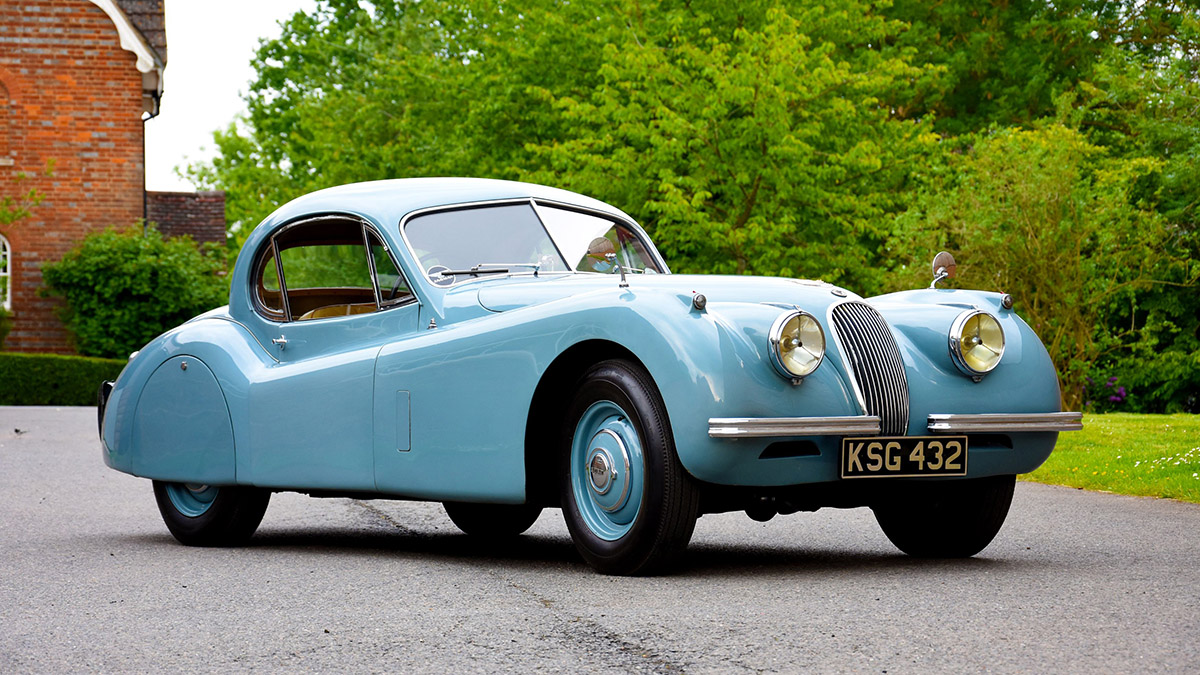BUYER’S GUIDE
Jaguar XK120 Review
The first Jaguar to use the legendary XK engine, the XK120 is a deservedly iconic post-war British classic…
Engine
3.4-litre six-cylinder, petrol
Power
162PS (119kW) @ 5,000rpm
Torque
264Nm (195lb ft) @ 2,500rpm
Kerb weight
c.1,220kg
0-62mph
c.12 seconds
What Is It?
As Jaguar busily reinvents itself as an electrically powered lifestyle brand, we shouldn’t forget its proud history and traditions of engineering innovation, styling artistry and sporting success. All of which combine to stunning effect in the XK120, and its embodiment of post-war rebirth and confidence.
Unveiled in 1948 as a bit of eye candy to launch Jaguar’s signature straight-six XK engine, the XK quickly became a symbol of Jaguar’s performance, style and, yes, value. As successful in motorsport as it was, exporting British automotive engineering savvy to the world, the XK120 remains beautiful, fast and great to drive.
Corrosive Areas
Headlight surrounds and sidelight fixings on front wings
B-pillars and rear box sections
Wheelarches
Checklist
- XK120 sold in three main versions, comprising Roadster (or Open Two Seater), Fixed Head Coupé (FHC) or Drop Head Coupé (DHC)
- FHC and DHC more luxurious, with wooden dash, wind-up windows and fully appointed interior
- Roadster is more minimalist, with basic weather protection, side screens and removable (rather than built-in) windscreen
- First 200-odd XK120s built with traditional aluminium skin over ash frames before more conventional steel bodies were introduced in 1950
- Optional SE (or ‘M’ in some markets) package included higher compression engine with 182PS (134kW), high-lift cams, lighter flywheel, wire wheels, stiffer suspension, twin-exit exhaust and bucket seats
- Aerodynamic rear wheel spats are a signature styling feature, though won’t fit over knock-off hubs of wire wheels
- Twin-cam 3.4-litre XK engine the first of a generation of engines powering Jaguars of all types well into the 1990s
- Standard drum brakes notably lacking in staying power – upgraded finned drums or discs not uncommon retrofits
- Most XKs were exported meaning genuine right-hand drive cars can be few and far between – conversions are not unheard of
- Popularity of tuning and interchangeability of engines and other parts from newer Jaguars means restomod ‘hot rodding’ is common – not necessarily an issue if the work is done to a suitably high standard, unless you prize originality
- Some Roadsters have been converted from Fixed Head Coupés – check chassis number if in any doubt
- Most cars will have been restored at some point in their lives, potentially several times over – where possible this should be fully documented and preferably with a respected specialist
- Whether steel-bodied or not, rust can take hold anywhere and be very costly to repair properly – check thoroughly
- If you’re lucky enough to find an aluminium bodied car, check condition of ash frame
How does it drive?
While the engine was very modern for the time, the rest of the XK120 is more traditional pre-war tech, with heavy recirculating ball steering, basic suspension and the famously recalcitrant Moss four-speed gearbox. So, you need to apply yourself to drive it properly. But a properly sorted XK should be an absolute delight, the physicality of the controls lessening as the speeds rise, the engine pulling strongly from low revs with that characteristic straight-six growl opening out to a cultured roar with strong, 100mph-plus performance still impressive to this day. Only the brakes disappoint, the standard drums struggling on a good day, prone to fade and often upgraded by keen drivers.
What’s good?
While the basic formula is the same across all variants, the XK120 offers a huge spectrum of styles to choose from, whether you prefer the Bugatti-esque streamliner look and luxury of a Fixed Head Coupé with spatted rear wheels, or a meaner, more motorsport inspired Roadster with mesh grille, aero screens and competition vibe celebrating the model’s many and various racing successes in period. Whichever you prefer, the XK120 is gorgeous to behold, fabulous to drive, guaranteed to score nods of approval from all who clap eyes on it and proudly representative of Jaguar’s post-war golden era.
What’s bad?
With a car this beautiful and iconic it can be hard to be objective. But buying an XK is not without its challenges or potential pitfalls. Enduring popularity is a double-edged sword, and half-baked or incompetent restorations can come back to haunt you, even if the car superficially presents as sound. Especially when it comes to bodywork repairs. So, do your homework, look at as many as you can before committing and make sure the history – especially relating to previous restoration work – adds up. Interchangeability of parts from later cars means many will have been upgraded or otherwise modified over their lives, which isn’t necessarily detrimental unless you’re really chasing originality. If you are, make sure you know what you’re looking at.
Which model to choose?
See above, but within the XK120 world there are many and subtly different vibes to choose from, so refine your selection according to taste. Beyond that, Roadsters are desirable for their racier, back-to-basics looks and stripped back styling but are fair-weather cars for all but the hardiest owners. Fixed Head Coupés are gorgeous, luxurious and arguably more versatile if you want to cover miles, Drop Head Coupés perhaps splitting the difference between the two. Genuine early aluminium-bodied cars will command a hefty premium and are appealing for their purist credentials, but unless you crave the bragging rights a steel-bodied car has all the style and most of the performance. As ever, once you’ve settled on your preferred body style, buying the best you can stretch to is ultimately the wisest advice!
Specifications – Jaguar XK120
Engine
3.4-litre six-cylinder, petrol
Power
162PS (119kW) @ 5,000rpm
Torque
264Nm (195lb ft) @ 2,500rpm
Transmission
Four-speed manual, rear-wheel drive
Kerb weight
c.1,220kg
0-62mph
c.12 seconds
Top speed
c.120mph
Production dates
1949-1954 (total production, all variants)
